Vicenza is most famous for the architecture of Andrea Palladio, who lived here 500 years ago. We shall see some of his buildings, but our focus is more on the people and the streets of this beautiful city. If you're staying in Venice you can get to Vicenza in 50 minutes by train, an ideal daytrip.

It's a very easy place to explore on foot for a day because the old town center is quite small, about one square kilometer, with many pedestrian lanes and beautiful historic sites. The town is like an outdoor museum, with a large collection of important historic buildings, beautifully preserved. It was founded by the Romans over 2000 years ago, with continuous occupation ever since.

With a population just over 100,000, it has a small town feeling and a high quality of life. It is not one of those crowded touristic places. You'll see mostly locals out taking a stroll, furnishing an authentic experience.

Piazza dei Signori is the very center of the old town, so it's a good place to begin our visit with views of the Palladian Basilica, one of Europe's most important buildings of the 16th century.

Alongside the Basilica in Piazza dei Signori is the Torre Bissara, 82 meters high, one of the tallest buildings in town. On the left side is the Palazzo del Capitaniato, designed by Palladio in 1565. The Basilica is surrounded on all four sides by piazzas, and the main pedestrian street Corso Andrea Palladio, is just a few blocks away.
Although Palladio called his building a Basilica, based on ancient Roman structures, it was not a church, but instead was used for civic functions like meetings, and festivities, and judicial proceedings. Today it is famous for the many jewelry stores all around the street level loggia. The copper-vaulted roof resembles the hull of an upended boat.
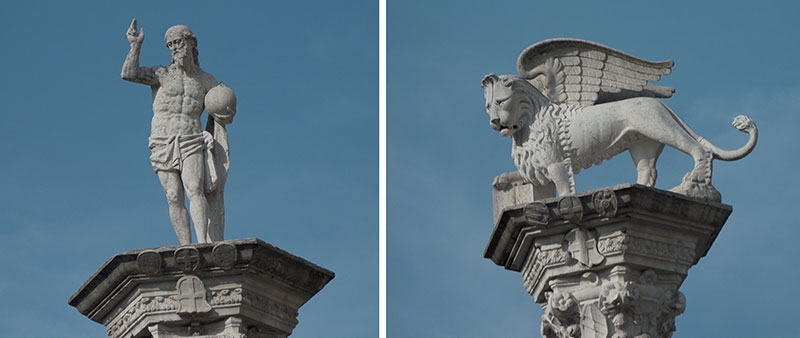
At one end of the piazza you'll see twin monumental columns, with Christ the Redeemer on top of one, and on the other, the lion of St. Mark, reminiscent of similar columns in Piazza San Marco in Venice, a city that has always been important to Vicenza.

The Tower of Torment was originally a home for a noble family in the 13th century and then became a prison for torture. It would be nice to drop anchor and have a spritz, join the local crowd at the little Piazzetta Andrea Palladio, next to the Basilica. You could easily miss it because it's the smallest of the four piazzas that surround the great building, and yet it's one of the coziest and most charming with these arcades and loggia all around.

Next to it, also adjacent to the Basilica which you see towering above, on top of those steps, is Piazza delle Erbe, serving up more spritz, that favorite local drink.
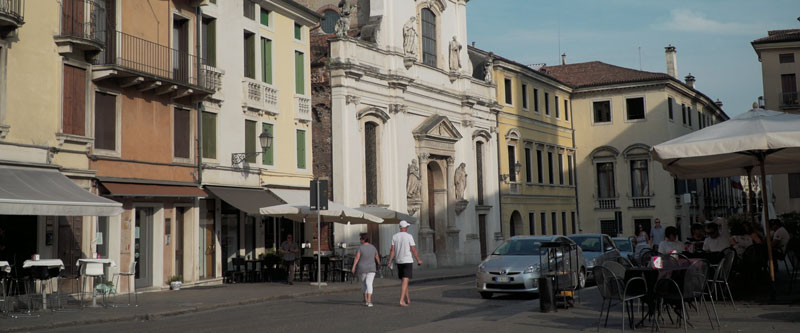
Another fine piazza is on the east end of the Basilica is Piazza delle Biade, with the Baroque Church of Santa Maria dei Servi, its façade influenced by the Venetian style.
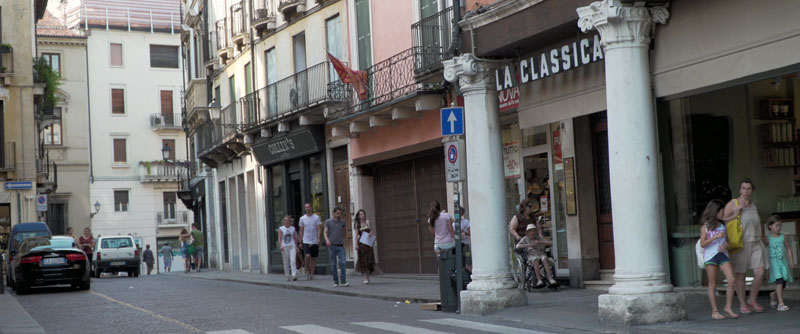
From the piazza we're heading north two blocks to the main pedestrian street, walking along the lovely Contrà Santa Barbara, one of many intriguing side lanes. We are going to take a walk through some of the nicest pedestrian lanes of town.
This main street of town is 700 meters long and lined with shops and cafés, local tailors, designers, big name brands like Zara and H&M, many of them housed in what had been palaces back in the days of the Renaissance.

It's the favorite place for locals to come out for a stroll, especially during the afternoon passeggiata, that fine Italian tradition of people-watching and greeting friends. Another favorite Italian tradition is trying to figure out which variety of gelato to order.
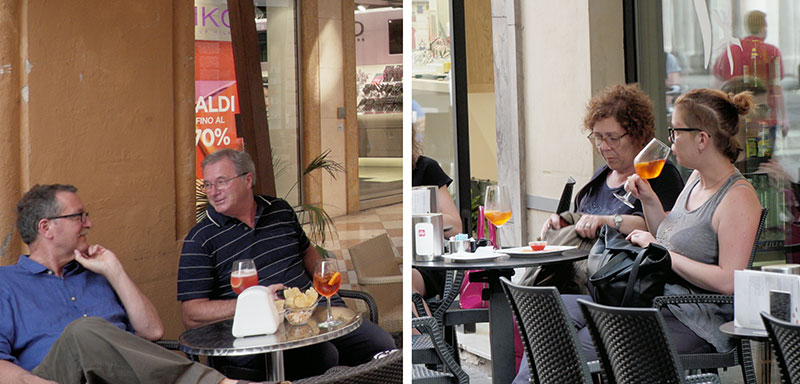
Or perhaps enjoying another spritz is more to your liking, while sitting at a sidewalk café and watching the people glide by.
The same piazza also has another important building designed by Palladio, the Teatro Olimpico, a faithful reproduction of the ancient style of Roman theater. The permanent stage front is decorated with statues, columns, triumphal arch and tricks of the illusion. Palladio was 72 when he designed this, which became his final work, which he never lived to see.
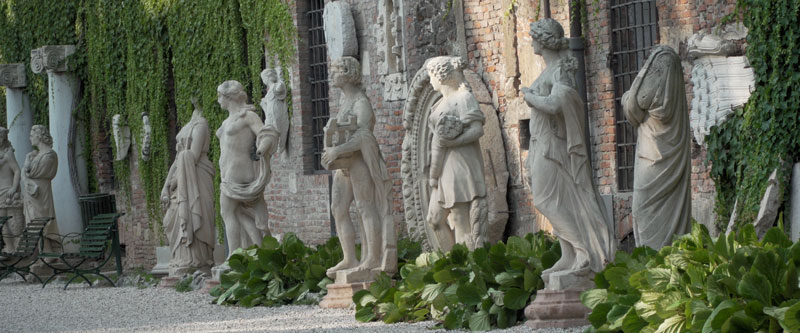
The theater is housed in the Palazzo del Territorio, with 19th-century statues in the garden done in the ancient Roman style. The Tourist Information Office is also found in this Palazzo, a very helpful source of information and tickets.
"The work of Palladio, based on a detailed study of classical Roman architecture, gives the city its unique appearance," according to a statement by UNESCO, which designated the city of Vicenza as a World Heritage Site because of the works of Palladio.

UNESCO says that his work "made a decisive influence on the development of architecture spreading to England other European countries, and also to North America. He became the inspiration for a movement without parallel and architectural history."
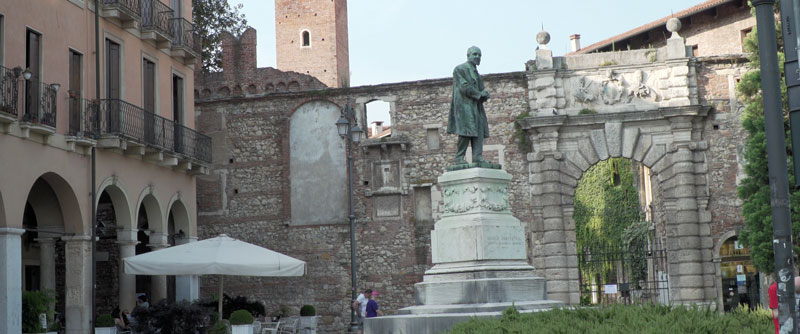
As we continue walking along that street that bears his name, consider some more praise from another important organization. The United States Congress adopted a resolution honoring Andre Palladio in the year 2010, celebrating the 500th anniversary of his birth.

Congress said: "Palladio’s designs for public works, churches, mansions and villas, rank among the most outstanding architectural achievements of the Italian Renaissance. He has shaped much of the architectural image of Western civilization and served as a primary source for classical design of many buildings in the US from Colonial times to the present....Including our Capitol Building, the White House, and countless architectural works of timeless dignity and beauty....The Congress expresses its gratitude for the enhancement his life and career has bestowed upon the built environment."
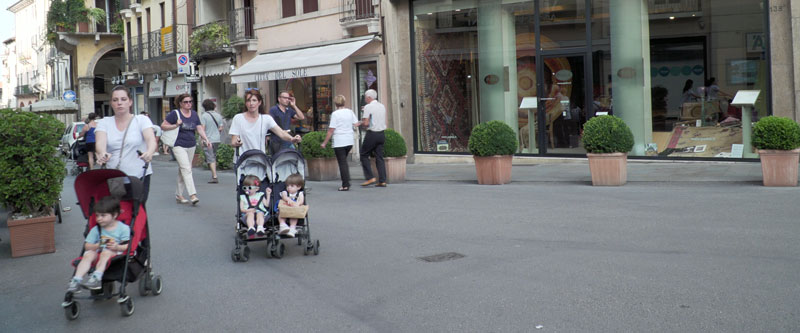
As UNESCO described it, "Vicenza is the city of Palladio." We just had space to show you a few of his buildings in this page, but there are 23 buildings designed by Palladio in Vicenza and the surrounding area, including some of his villas, and we will show a couple more of his palaces in town coming up, but there's so much to see that you just might want to stay in Vicenza for a couple of days, rather than visiting it as a daytrip as we've been doing.

The magnificent Palazzo Trissino-Baston is the largest palace along the Corso, home of that noble family in the 17th century, and more recently the City Hall. While it's a bonus that Vicenza has such architectural interest and importance, I find the nicest part of being here is just simply walking around, especially on the little side streets. It's very quiet and peaceful here.

The most spectacular palace along the street is found at the east end, the Palazzo Chiericati, designed by Palladio in 1550 in that Renaissance style, and completed in the late 17th century. Now it's the Civic Museum, with a collection of paintings, prints, drawings, with medieval and modern statues.
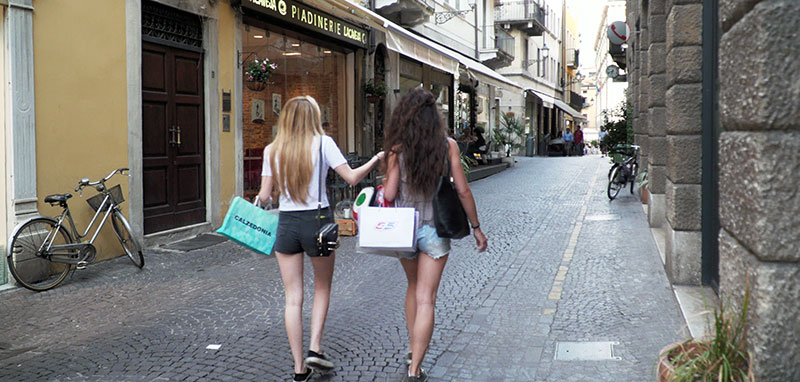
There are some fascinating side streets reserved for pedestrians that branch off from the main Corso and lead back to the Piazza dei Signori. Posted signs and maps can help steer you to the various sites. The cobblestone paving is nice and smooth and comfortable underfoot. The arcade-covered sidewalks are also a delight for the eyes.
Duomo
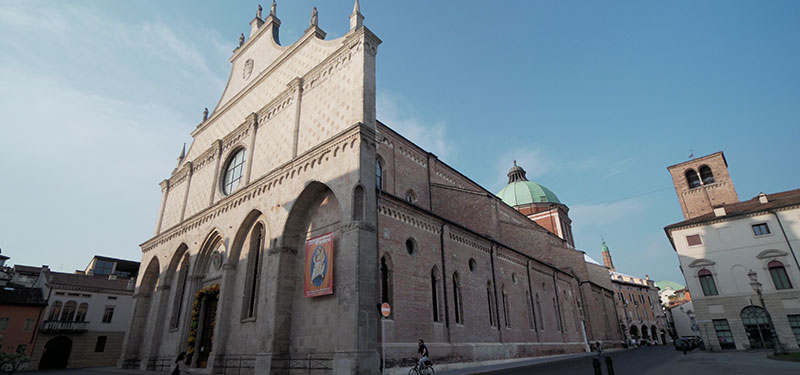
We are reaching the end of the pedestrian zone on Corso Palladio, finding the Duomo one block over. The cathedral is the church of Santa Maria Annunciata, and first dates from the early 11th century, although it's been restored numerous times, such as after World War II when it was nearly totally destroyed. Palladio designed the dome.
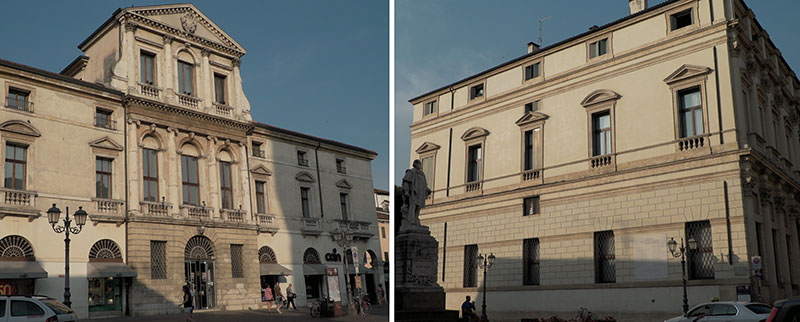
He also designed the palace on the right, which is just across the street from Piazza Del Castello. The tall palace on the left side was not designed by Palladio but influenced by his style. It was built in the 17th century as a residence for the Piovini family, later divided into separate households and shops. Now it's a department store.

Heading for the train station, we reach the fortified gate of Porta Castello, which was part of the medieval wall that went all the way around Vicenza. Back in the 12th and 13th centuries there were some conflicts and alliances between the cities, such as Padua, Treviso, and Verona, with the smaller town of Vicenza sometimes caught in the middle, defended by its wall and the fortified Torrioni Tower, which is now open as an art museum.
And that completes our brief visit to Vicenza. There is more to discover here so you better go and see it for yourself. This is a beautiful place.

It's an easy 500 meters walk from the center to the train station to catch a train back to Venice, if this was your daytrip. You can get to Vicenza in the late morning and leave at 8 PM, back to Venice in time for dinner at nine, or maybe linger in Vicenza for dinner there. If you get the semi-express train it makes only two stops on the way, and you'll arrive in Venice in 47 minutes. But the local train makes 10 stops along the way, and it takes an hour and 20 minutes. So it's wise to plan ahead and get that semi-express. The price is only about €10 and you don't need any seat reservations, especially when you're traveling in the evening like this. The trains are just not very busy and you'll soon be back in beautiful Venice.
After the long day you are eager to be home, even if home is just a hotel in Venice.
Watch the same video on the dedicated video page.
Google map of Vicenza with highlights from our visit.